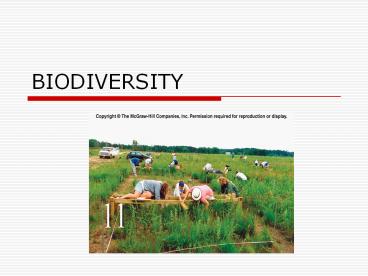BIODIVERSITY - PowerPoint PPT Presentation
Title: BIODIVERSITY
1
BIODIVERSITY
2
What is Biodiversity
- Genetic diversity the variety of different
versions of the same genes within individual
species. - Species diversity the number of different kinds
of organisms within individual communities or
ecosystems. - Ecological diversity assesses the richness and
complexity of a community includes niches,
trophic levels, ecological relationships, etc.
3
Biodiversity Hot Spots
- The greatest concentration of different organisms
tends to be in the tropics, especially in
tropical rainforests, coral reefs, and tropical
estuaries. - Endemic Species species that exist only where
they originated and nowhere else on earth - There are roughly 25 hot spots that represent a
high priority for conservation because they have
both high biodiversity and a high risk of
disruption by human activities.
4
How Do We Benefit From Biodiversity?
- Even seemingly obscure and insignificant
organisms can play irreplaceable roles in
ecological systems and biological controls or be
the source of food, genes, or drugs that someday
may be indispensable. - Ecological systems roles
- Soil formation
- Waste disposal
- Air and water purification
- Nutrient cycling
- Solar energy absorption
- Management of biogeochemical cycles
5
What Threatens Biodiversity?
- Extinction we are in the midst of the greatest
extinction since the end of the Permian period
about 250 mya when 95 of all marine species and
nearly half of all plant and animal families died
out over a period of about 10,000 years. (This is
a very short amount of time in the evolutionary
scheme of things!) - The extinction occurring right now is due mostly
to Habitat destruction, followed by Invasive
species, Pollution, overPopulation, and
Overharvesting (HIPPO).
6
HIPPO
- Habitat Destruction
- Clear cutting of forests for grazing animals
(McDonaldsbad!!!) - Conversion of grasslands to crop fields
- Construction, including houses, roads, public
buildings, etc. - Mining
- Dams
- Bottom Trawling Fishing heavy nets are dragged
across the ocean floor, scooping up every living
thing and crushing the bottom structure to
lifeless rubble. - When some small, scattered habitats are preserved
in isolation, it is referred to as fragmentation.
The preservation arises from good intentions,
but actually serve the organisms very little
because even small animals need vast expanses of
land in order to survive.
7
HIPPO
- Invasive Species
- These species thrive because they have no natural
predators in their new environments no natural
diseases in their new environments no limits on
resources in their new environments. - Invasive species are usually brought in by
humans, although not always intentionally. Come
in on boats, planes, trains, cars, on shoes,
clothes, etc. - Invasive species can include bacteria, fungi, and
viruses.
8
HIPPO
- Pollution
- Mercury
- Lead
- Atrazine (pesticide)
- PCBs, polychlorinated biphenyls (a class of
man-made compounds that were manufactured and
used extensively in electrical equipment such as
transformers and capacitors, paints, printing
inks, paper, pesticides, hydraulic fluids,
lubricants, synthetic rubber, plasticizers, floor
tile, brake linings, adhesives, carbon copy
paper, fluorescent light ballasts, and asphalt,
to name a few)
9
HIPPO
- overPopulation
- If our consumption patterns remain the same, with
more people, we will need to harvest more timber,
catch more fish, plow more land for agriculture,
dig up more fossil fuels and minerals, build more
houses, and use more water. All of these demand
impact wild species, both plant and animal!
10
HIPPO
- Overharvesting
- Overfishing
- Overhunting
- Poaching
- Keeping wild animals as pets
11
Endangered Species Management Biodiversity
Protection
- U.S. Endangered Species Act of 1973 regulates
harassing, harming, pursuing, hunting, shooting,
trapping, killing, capturing, collecting,
importing, exporting, possessing, selling,
transporting, or shipping, either accidentally or
on purpose, of ANY endangered species. This
applies to live organisms, body parts, and
products made from endangered species. - Endangered those species in imminent danger of
extinction. - Threatened those that are likely to become
endangered - Vulnerable naturally rare or locally depleted,
could become threatened or endangered.
12
Recovery Plans
- The ESA sounds good in theory, but due to limited
funds, politics, and the emotions of the human
population, sometimes, not much is done for
species on the brink. - In the rare case that something is done, the Fish
and Wildlife Service is the first one notified
and they are required to prepare a recovery plan
detailing how populations will be rebuilt to
sustainable levels. (This usually takes
yearsmore time than some species have left!)
13
What If An Endangered Species Is On Your
Property?
- You are bound by law to protect it!
- However, the Fish and Wildlife Service has been
negotiating agreements called habitat
conservation plans with private landowners to
allow them to harvest resources or build on part
of their land as long as the species benefits
overall.(Basically as long as they donate money
to the cause, they are allowed to destroy the
habitat or the animal itself!)
14
ESA continued
- ESA officially expired in 1992, however, its
still in effect because Congress cannot agree on
how it should be updated.































